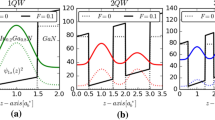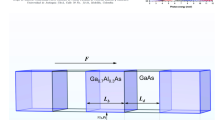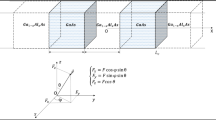Abstract
Impurities of different chemical elements inevitably emerge during the preparation of semiconductor nanostructures or are intentionally added to change their transport and optical properties. Most impurities in a bound state can have two or more electrons, rather than one electron. In this case, interelectronic correlations enabling the double photoionization of an impurity atom, one of fundamental reactions, start to play an important role. The aim of the present work was to calculate the first ionization potential of a two-electron impurity center in a semiconductor quantum well by the variation method, as well as to theoretically study the effect of correlations on the double photoionization spectra of two-electron impurity centers in a multiwell quantum structure. The bond energy and first ionization potential of a two-electron atom were calculated by the variation method where the second ionization potential was taken as an empirical parameter. The expression for the impurity light absorption coefficient was obtained in the dipole approximation taking into account the quantum-well width variance. The zero-radius potential method was generalized to the case of two-electron impurities with zero effective nuclear charge in semiconductor quantum wells. An analytical expression for the first ionization potential of a two-electron impurity center was obtained by the variation method in terms of the semiempirical model. The impurity light absorption coefficient upon the one-photon photoionization of a two-electron impurity in a multiwell quantum structure was calculated in the dipole approximation. It is shown that, due to the spatial restriction in a quantum well in one direction, electronic correlations are enhanced to result in higher threshold values of the second ionization potential than those in quantum dots and, as a consequence, more rigid existence conditions of two-electron impurity states. Also, a decrease in the quantum size effect and an increase in the electronic correlation in multiwell quantum structures compared to quasi-zero-dimensional structures were shown to result in transformation of the absorption curve, which is expressed in an increase in the dip between peaks in the double-humped spectral curve.


Similar content being viewed by others
REFERENCES
G. P. Anisimova, E. L. Kapel’kina, R. I. Semenov, and V. I. Tuchkin, Opt. Spektrosk. 81 (4), 543 (1996).
S. A. Zaitsev and V. A. Knyr, Vestn. Tikhookean. Gos. Univ., No. 1 (16), 13 (2010).
M. S. Aleshin and S. A. Zaitsev, Vestn. Tikhookean. Gos. Univ., No. 3 (22), 13 (2011).
A. I. Mikhailov and I. A. Mikhailov, Zh. Eksp. Teor. Fiz. 116 (6), 1889 (1999).
M. K. Eseev and V. I. Matveev, Tech. Phys. 53 (8), 985 (2008). https://doi.org/10.1134/S1063784208080057
M. E. Presnyakov and D. B. Uskov, Pis’ma Zh. Eksp. Teor. Fiz. 66 (1), 23 (1997).
V. I. Matveev and E. S. Parilis, Sov. Phys.-Usp. 25, 881 (1982). https://doi.org/10.1070/PU1982v025n12ABEH005003
E. A. Volkova, A. M. Popov, and O. V. Tikhonova, J. Exp. Theor. Phys. 91, 706 (2000). https://doi.org/10.1134/1.1326963
N. B. Delone, B. A. Zon, V. P. Krainov, and M. A. Preobrazhenskii, Pis’ma Zh. Eksp. Teor. Fiz. 30 (5), 260 (1979).
E. V. Gryzlova, A. I. Magunov, I. Rotter, and S. I. Strakhova, Quantum Electron. 35 (1), 43 (2005). https://doi.org/10.1070/QE2005v035n01ABEH002787
B. A. Nadykto, Phys.-Usp. 36 (9), 794 (1993). https://doi.org/10.1070/PU1993v036n09ABEH002307
R. K. Pandey, M. K. Harbola, and V. A. Singh, J. Phys.: Condens. Matter 16, 1769 (2004). https://doi.org/10.1088/0953-8984/16/10/009
M. O. Krause and F. Wulleumier, Electron and Photon Interactions with Atoms (Plenum, New York, 1976), p. 89.
A. A. Grinberg and E. D. Belorusets, Fiz. Tverd. Tela 12 (10), 1970 (1978).
V. D. Krevchik, A. V. Razumov, and P. S. Budyanskii, Izv. Vyssh. Uchebn. Zaved., Povolzhsk. Reg. Fiz.-Mat. Nauki, No. 3 (33), 228 (2014).
V. D. Krevchik and A. Ya. Yafasov, Fiz. Tekh. Poluprovodn. 15, 2263 (1981).
Funding
This study was supported by the Ministry of Science and Higher Education of the Russian Federation, grant no. 0748-2020-0012.
Author information
Authors and Affiliations
Corresponding author
Ethics declarations
The authors declare that they have no conflicts of interest.
Additional information
Translated by K. Utegenov
Rights and permissions
About this article
Cite this article
Krevchik, V.D., Razumov, A.V., Semenov, M.B. et al. The Effect of Electronic Correlations on the Double Photoionization Spectra of Two-Electron Impurity Centers in Multiwell Quantum Structures. Tech. Phys. 67, 498–507 (2022). https://doi.org/10.1134/S1063784222070052
Received:
Revised:
Accepted:
Published:
Issue Date:
DOI: https://doi.org/10.1134/S1063784222070052




